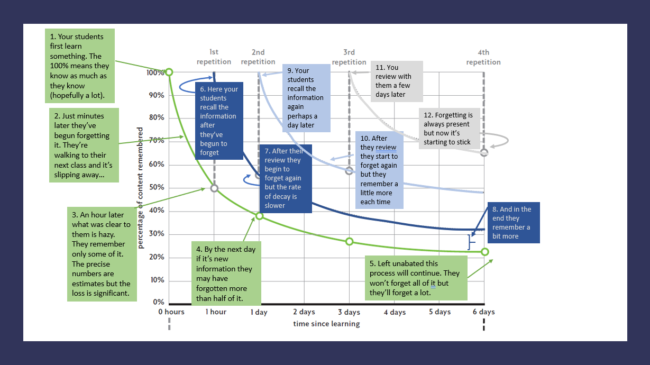02.08.21An Annotated Forgetting Curve

Just last month I finally completed and published The Coach’s Guide to Teaching; this month I’m wrapping up the manuscript to the new 3.0 version of Teach Like a Champion.
One of its themes of 3.0 is making clearer and more extensive connections to research so one thing the two books will have in common is discussion of the importance of forgetting–Retrieval Practice is a new technique in 3.0 and the role of forgetting for athletes is the subject of chapter 2 in CGT.
As a result, both books discuss the ‘Forgetting Curve,’ the graph describing how learners forget things over time and how retrieval practice can arrest this process.
The original Forgetting Curve was derived in the 1880s by the German psychologist Hermann Ebbinghaus and plotted the actual rate at which he was able to remember a series of nonsense syllables after learning them. The general shape of the curve is broadly accepted by cognitive psychologists. But since your students aren’t learning nonsense syllables, the rate at which they forget what they have learned after they learned it is less clear. So what the Forgetting curve tells us that:
- as soon as you learn something, you begin forgetting it almost immediately.
- the rate of forgetting is often shockingly high; a few hours after learning something, people routinely remember only a small fraction of it.
- each time you practice recalling what you know, the rate and amount of forgetting is reduced somewhat.
- retrieving something back into working memory slows the rate of forgetting, but how and when the retrieval happens is important.
But a Forgetting Curve cannot tell you exactly what the rate of retention will be for your students generally or for a specific student at time A or time B for a specific topic you’ve taught. There are individual differences and factors in the learning environment, like how much attention students are paying and how new to students the information is/ There are differences in content too: abstract and complex ideas; simpler and more concrete.
So the curve in is also theoretical or hypothetical in any specific case.
And it also leaves open what the magic number of times students have to engage something to learn it. Graham Nuthall’s Hidden Lives of Learners proposes that whether a student was exposed to content three times can predict with 80-85% accuracy whether they successfully learned it.
Anyway, the Forgetting Curve is a highly useful and also imperfect tool but one educators should know. That said it’s actually complex to read one the first time you encounter it and I get questions from educators about it all the time. So as part of TLAC 3.0 i am toying with the idea of an annotated Forgetting Curve… one with descriptions build in so it’s more portable and how to read it is more readily apparent. Here’s a draft in case it’s useful first the annotated curve:

And then a clean version:

I’ve temporarily adapted both from a drawing of it the amazing Oliver Caviglioli made for CGT. Hope its useful!
